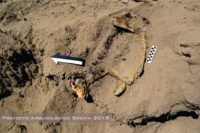 The well-preserved remains of a 1000-year-old dog have been discovered in the Sechin archaeological site in Peru. The dog’s remains are in excellent condition, with significant patches of yellow and brown fur and toe pads still extant.
The well-preserved remains of a 1000-year-old dog have been discovered in the Sechin archaeological site in Peru. The dog’s remains are in excellent condition, with significant patches of yellow and brown fur and toe pads still extant.
Sechin, a prehistoric site in northern Peru’s Casma and Sechin river valleys, was inhabited from at least 7600 B.C., the earliest radiocarbon date result from the settlement. Very little is known about the population, but the site was occupied by the Casma/Sechin culture for thousands of years. By 3600 B.C. they were building monumental structures like pyramids, plazas and friezes. The plaza and frieze at Sechin Bajo are the two oldest monumental structures known in the Americas. The Casma/Sechin culture appears to have abandoned Sechin as a result of a war around 100 B.C., but they would later reoccupy it.
The dog’s remains, which date to the reoccupation period, are the second discovery made by the archaeological team since excavations began. It was discovered in the main structure of Sechin, a monumental complex believed to have had religious purpose. Preliminary investigation of the dog suggest it was a native breed from the prehispanic era that was used in the temple.
The excavation project aims to find out more about the history and people Sechin. More finds are expected now the dig has encountered the most recent habitation layer. This first stage of excavations will end in November. After a break for winter, the next stage will begin.
Video: Gonzalo Horna pic.twitter.com/fuaFXTVTjj— Agencia Andina (@Agencia_Andina) October 4, 2019
The first dogs in the Americas arrived from Siberia, I guess with the people who arrived via Beringia. I hope it’s possible to do genetic testing on this good friend, to identify his origins.
Now that’s an old dog.
That Dog… Yes, what is wrong with it, it might be resting!